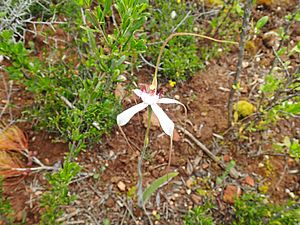Darling Scarp white spider orchid facts for kids
Quick facts for kids Darling Scarp white spider orchid |
|
|---|---|
 |
|
| Caladenia longicauda subsp. clivicola growing near Dunsborough | |
| Scientific classification |
|
| Kingdom: | Plantae |
| Clade: | Tracheophytes |
| Clade: | Angiosperms |
| Clade: | Monocots |
| Order: | Asparagales |
| Family: | Orchidaceae |
| Subfamily: | Orchidoideae |
| Tribe: | Diurideae |
| Genus: | Caladenia |
| Species: | |
| Subspecies: |
C. l. subsp. clivicola
|
| Trinomial name | |
| Caladenia longicauda subsp. clivicola Hopper & A.P.Br.
|
|
| Synonyms | |
|
Arachnorchis longicauda subsp.clivicola (Hopper & A.P.Br.) D.L.Jones & M.A.Clem. |
|
The Caladenia longicauda subsp. clivicola, also known as the Darling Scarp white spider orchid or hills white spider orchid, is a special plant. It belongs to the amazing orchid family. This orchid is found only in the south-west part of Western Australia. This means it is endemic to that area.
This unique orchid has one furry leaf. It can grow up to three mostly white flowers. These flowers have long, hanging parts called sepals and petals. The orchid also has a small, narrow labellum, which is a special lip-like petal. Its labellum has narrow teeth. You can find this orchid mostly in a specific area, especially on the Darling Scarp.
Contents
What Does This Orchid Look Like?
The Darling Scarp white spider orchid is a terrestrial plant. This means it grows in the ground. It is also a perennial herb, which means it lives for many years. It has an underground tuber, which is like a small potato. This tuber helps it store food.
The orchid has a single hairy leaf. This leaf is usually about 12 to 25 centimetres (5 to 10 inches) long. It is also about 6 to 12 millimetres (0.2 to 0.5 inches) wide.
Up to three flowers grow on a tall stem. This stem can be 30 to 50 centimetres (12 to 20 inches) high. Each flower is mostly white. They are quite large, about 10 to 15 centimetres (4 to 6 inches) long. They can also be 7 to 10 centimetres (3 to 4 inches) wide.
The side sepals and petals of the flower have long tips that hang down. The top sepal stands straight up. The labellum (the orchid's special lip) is mostly white. It is about 15 to 25 millimetres (0.6 to 1 inch) long. It is also 7 to 10 millimetres (0.3 to 0.4 inches) wide. The labellum has narrow teeth on its sides. These teeth can be up to 5 millimetres (0.2 inches) long.
In the middle of the labellum, there are many small, pale red bumps. These bumps are called calli. They are arranged in four or more rows. Each callus is very tiny, about 1.5 millimetres (0.06 inches) long. This orchid usually blooms from September to October.
How Did It Get Its Name?
The main type of orchid, Caladenia longicauda, was first officially described in 1840. This description was made by a person named John Lindley. It was written in a book called A Sketch of the Vegetation of the Swan River Colony.
Later, in 2001, two scientists, Stephen Hopper and Andrew Brown, looked closer at this orchid. They described eleven different subspecies, which are like different types within the same species. One of these new subspecies was clivicola. Their descriptions were published in a science journal called Nuytsia.
The name clivicola comes from two Latin words. Clivus means "hillside." -cola means "dweller." So, clivicola means "hillside dweller." This name was chosen because this orchid subspecies was found living on the sloping hills of the Darling Scarp.
Where Does This Orchid Live?
The Darling Scarp white spider orchid mostly lives on the Darling Scarp. This area is near a town called Harvey. You can also find it near Dunsborough.
It grows in special areas called the Jarrah Forest and Swan Coastal Plain. These are biogeographic regions, which are large areas with similar plants and animals. The orchid likes to grow in forests and shrublands. It is often found near large granite rocks.
Is It Safe?
The Western Australian Government's Department of Parks and Wildlife checks on plants and animals. They have looked at Caladenia longicauda subsp. clivicola. They have said that it is "not threatened." This means it is not currently in danger of disappearing.
Images for kids


